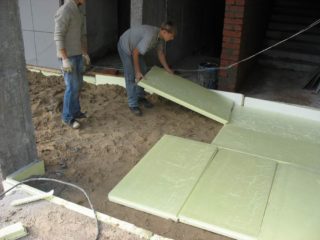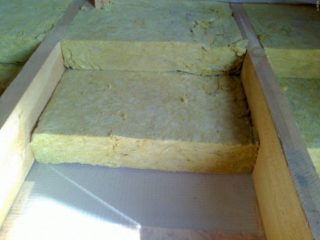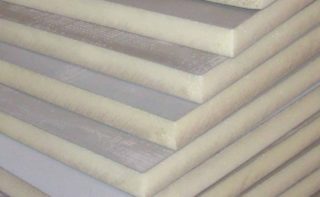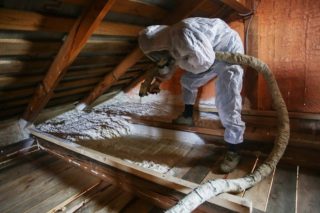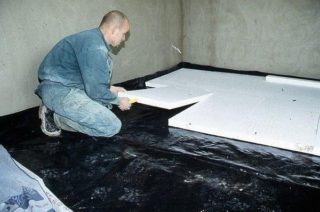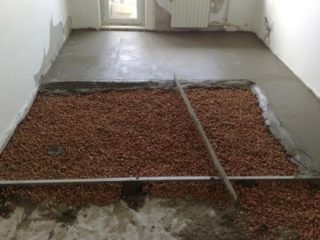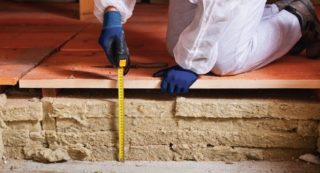It is important to decide what kind of insulation for the floor to use if in winter a large amount of heat leaves through the cracks. Typically, 20% of the heat energy is volatilized through concrete floors. This applies not only to apartments in high-rise buildings, but also rooms in private houses.
The importance of quality floor insulation
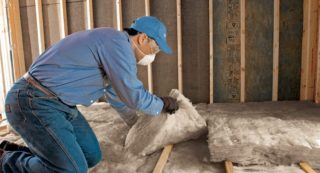
Due to the transfer of accumulated heat through the floor covering, it becomes necessary to insulate the surface with the help of special materials. As a result of maintaining heating inside the room by thermal insulation, it is possible to achieve:
- comfortable temperature in the room;
- lack of draft through the cracks of the parquet;
- maintaining the facing material in an attractive form;
- warnings in the formation of mold and mildew.
Due to the ingress of heat under the cold flooring, dampness forms inside. In the future, it affects the destruction of the material. At the same time, strengthening the thermal insulation of the roof and partitions will not help keep the heat.
Varieties of materials
A fairly wide range of products for floor insulation is on sale. Materials can be multifunctional.
Expanded polystyrene
Made of special granules having good density. The heater is modern and easy to use. It has several advantages:
- durable, lightweight and hardy;
- creates a minimum load on the foundation;
- moisture resistant;
- does not absorb heat;
- belongs to the budget category of building materials.
Expanded polystyrene lends itself to combustion and melting; when heated, it releases toxic substances.
Mineral insulation
They are divided into several types:
- Mineral wool. It consists of small fibers glued together using a special composition. This raw material has high strength, is sold in the form of rolls and plates. It is characterized by low thermal conductivity, good heat and noise insulation, does not accumulate dampness and resists the formation of mold. It is divided into basalt, stone and glass wool.
- Foam glass. Means the made foam molten glass. It differs in such properties: effective thermal insulation, resistance to temperature extremes, increased wear resistance and durability. The material resists mold and mildew. Foam glass is easily mounted under the finish floor covering.
- Expanded clay. This is clay in granules obtained by roasting. She is poured into pre-prepared niches in the floor, then poured with a concrete screed. Raw materials are easy to install, non-combustible, considered environmentally friendly. The insulation will serve for a long time even with sudden changes in temperature. Often used to warm the floor above the basement.
When working with expanded clay, it is necessary to wear a respirator, since the material emits a lot of dust at the time of filling. She subsequently settles in the lungs.
Foil materials
There are several options for raw materials that are used to insulate the floor.
- Foamed polystyrene foam. It is a thick plate, the lower part of which is made of granules by soldering them together. The upper part has a layer of foil. Withstands the temperature range from -180 to +180 degrees.
- Foamed polyethylene in a roll. It is a canvas consisting of foil and a thin substrate.Most often used for flooring with laminate or parquet sheet. The raw materials are easy to install (insulation on the floor is quite simple to lay, after preparing it).
- Mineral wool with foil. One of the common options for thick insulation. The base is fiberglass or basalt mats. Nevertheless, such raw materials are unacceptable to use in the apartment because of the likelihood of small glass fragments falling out.
- Basalt insulation. This heat insulator is made on the basis of mineral wool, has a small thickness. Withstands temperature extremes within the range of -200- + 700 degrees. It is used for floors between floors.
Depending on the layer thickness and the presence of additional compositions in the materials, they will all differ in marking.
Penoizol
Penoizol is recognized as the most effective and affordable material for the organization of thermal insulation of floors. The structure has a liquid texture, so it easily fills all the cracks, thereby retaining heat under the floor covering. This insulation is suitable for floors and walls.
Sprayable thermal insulation
The principle of action is similar to penoizol. The spraying process occurs only after preparation and filling of the suspension. This material consists of two components. The advantages of such floor insulation are the speed of installation and the ability to fix with any surface. Nevertheless, the product is unsafe, as it can injure the skin and enter the respiratory system. You need to work with him in a respirator and a special suit.
Sprayed thermal insulation is unacceptable if there are large cracks in the floor screed. When ingested, they begin to expand and create an additional burden on the foundation.
Bung
Cork material is considered one of the most popular, it is used to warm the floor in the house before linoleum flooring. The canvas is easy to install, perfectly fills the empty space, thereby retaining heat in the room.
Which is better to choose
It is necessary to choose the material for insulation correctly. If the house is installed on a monolithic foundation, it is best to give preference to materials that do not absorb moisture. To warm the house installed on piles, it is better to use dimensional means in the form of mats or rolls: mineral wool or foil sheets.
In apartment buildings for insulation between floors, they try to mount elements with a foam composition. It is quite lightweight, does not create a load on monolithic plates.
How to put thermal insulation material
Each insulating material has its own way of laying. Each of them has some difficulties and principles that you need to know about in order to prevent mistakes.
- Foam masonry is carried out by different methods. The most common is floating. It involves laying sheets of polystyrene foam on the surface, after which a concrete screed is performed.
- Expanded clay is laid in a semi-wet or dry manner. For this, expanded clay is mixed with water and the prepared niche is poured with the composition. Such a heater dries up for 2-3 days.
- Ecowool flooring. She is poured into prepared compartments, subsequently pour special adhesive. In the process of drying, the bonding of cotton fibers and the sealing of the floor take place. Parquet boards are laid on top of the insulation.
- Penoizol insulation. The surface is pre-prepared and all the garbage removed. It is important that the temperature reaches 10 degrees at the time of floor insulation. Spray the product evenly and allow two days to dry.
When spraying insulating material, the evenness of the surface does not matter, the main thing is that there are no residues of construction debris and dust. Otherwise, the tightness of the insulation will be difficult to achieve.
What problems can be encountered when warming the floor
Not always insulating the floor solves all the problems with the leakage of thermal energy through the cracks. This is due to common mistakes that are often made during the initial laying of the insulation.
- Incorrect storage and further laying of the insulation. Often, before laying the thermal insulation, they forget to put it out of the package. It is advisable to do this a day before masonry. At the same time, leaving it open for longer is unacceptable. The external environment can negatively affect the properties of the material.
- The presence of gaps between the polystyrene foam. If you can’t accurately cut out the shapes and put them between the lags, it is better to blow out the seams with foam. Otherwise, there will be bridges of cold, which will draw warm air out of the room.
- Too thin layer of insulation. The defect will play a huge role in the release of heat. Such savings will cost additional costs, since isolation is not able to perform its functions. The thickness of the mineral wool should be at least 14 cm, and expanded clay - 27 cm.
Insulation of the floor at home is available for both the apartment and for private ownership. However, each structure has its own principles of thermal insulation. They must be observed so that the design retains its properties for many years.
